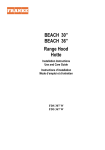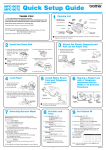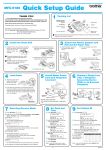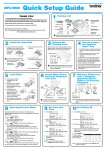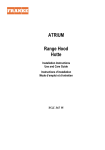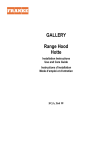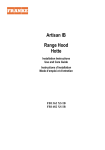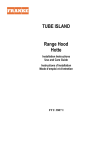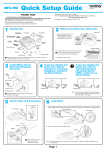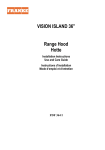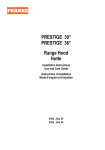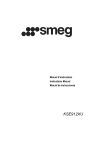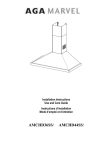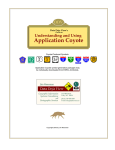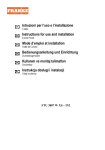Download TUBE WALL Range Hood Hotte
Transcript
TUBE WALL Range Hood Hotte Installation Instructions Use and Care Guide Instructions d’installation Mode d’emploi et d’entretien FTU 3807 W INDEX WARNINGS AND REQUIREMENTS .....................................................................................................................................3 RECOMMENDATIONS AND SUGGESTIONS ......................................................................................................................6 DIMENSIONS and MAIN PARTS...........................................................................................................................................7 INSTALLATION ......................................................................................................................................................................8 USE.......................................................................................................................................................................................12 CARE ....................................................................................................................................................................................13 EN 2 2 READ AND SAVE THESE INSTRUCTIONS The Installer must leave these instructions with the homeowner. The homeowner must keep these instructions for future reference and for local electrical inspectors’ use. READ THESE INSTRUCTIONS BEFORE YOU START INSTALLING THIS RANGEHOOD WARNING: - TO REDUCE THE RISK OF A RANGE TOP GREASE FIRE: Never leave surface units unattended at high settings. Boilovers cause smoking and greasy spillovers that may ignite. Heat oils slowly on low or medium setting. Always turn hood ON when cooking at high heat or when flambéing food (i.e. Crepes Suzette, Cherries Jubilee, Peppercorn Beef Flambé. Clean ventilating fans frequently. Grease should not be allowed to accumulate on fan or filter. Use proper pan size. Always use cookware appropriate for the size of the surface element. WARNING: - TO REDUCE THE RISK OF INJURY TO PERSONS IN THE EVENT OF A RANGE TOP GREASE FIRE, OBSERVE THE FOLLOWING: SMOTHER FLAMES with a close-fitting lid, cookie sheet, or metal tray, then turn off the burner. BE CAREFUL TO PREVENT BURNS. If the flames do not go out immediately EVACUATE AND CALL THE FIRE DEPARTMENT. NEVER PICK UP A FLAMING PAN - You may be burned. DO NOT USE WATER, including wet dishcloths or towels - a violent steam explosion will result. Use an extinguisher ONLY if: 1. You know you have a Class ABC extinguisher, and you already know how to operate it. 2. The fire is small and contained in the area where it started. 3. The fire department is being called. 4. You can fight the fire with your back to an exit. ALL WALL AND FLOOR OPENINGS WHERE THE RANGEHOOD IS INSTALLED MUST BE SEALED. This rangehood requires at least 22" of clearance between the bottom of the rangehood and the cooking surface or countertop. This minimum clearance may be higher depending on local building code. Consult the cooktop or range installation instructions given by the manufacturer before making any cutouts. MOBILE HOME INSTALLATION. The installation of this rangehood must conform to the Manufactured Home Construction and Safety Standards, Title 24 CFR, Part 3280 (formerly Federal Standard for Mobile Home Construction and Safety, Title 24, HUD, Part 280). Four wire power supply must be used and the appliance wiring must be revised. See Electrical Requirements. VENTING REQUIREMENTS CAUTION - To reduce risk of fire and to properly exhaust air, be sure to duct air outside – Do not vent exhaust air into spaces within walls or ceilings or into attics, crawl spaces, or garages". Determine which venting method is best for your application. Ductwork can extend either through the wall or the roof. The length of the ductwork and the number of elbows should be kept to a minimum to provide efficient performance. The size of the ductwork should be uniform. Do not install two elbows together. Use duct tape to seal all joints in the ductwork system. Use caulking to seal exterior wall or floor opening around the cap. Flexible ductwork is not recommended. Flexible ductwork creates back pressure and air turbulence that greatly reduces performance. Make sure there is proper clearance within the wall or floor for exhaust duct before making cutouts. Do not cut a joist or stud unless absolutely necessary. If a joist or stud must be cut, then a supporting frame must be constructed. WARNING - To Reduce The Risk Of Fire, Use Only Metal Ductwork. EN 3 3 WARNING • • • • • • Venting system MUST terminate outside the home. DO NOT terminate the ductwork in an attic or other enclosed space. DO NOT use 4" laundry-type wall caps. Flexible-type ductwork is NOT recommended. DO NOT obstruct the flow of combustion and ventilation air. Failure to follow venting requirements may result in a fire. ELECTRICAL REQUIREMENTS A 120 volt, 60 Hz AC-only electrical supply is required on a separate 15 amp fused circuit. A timedelay fuse or circuit breaker is recommended. The fuse must be sized per local codes in accordance with the electrical rating of this unit as specified on the serial/rating plate located inside the unit near the field wiring compartment. THIS UNIT MUST BE CONNECTED WITH COPPER WIRE ONLY. Wire sizes must conform to the requirements of the National Electrical Code, ANSI/NFPA 70 - latest edition, and all local codes and ordinances. Wire size and connections must conform with the rating of the appliance. Copies of the standard listed above may be obtained from: National Fire Protection Association Batterymarch Park Quincy, Massachusetts 02269 This appliance should be connected directly to the fused disconnect (or circuit breaker) through flexible, armored or nonmetallic sheathed copper cable. Allow some slack in the cable so the appliance can be moved if servicing is ever necessary. A UL Listed, 1/2" conduit connector must be provided at each end of the power supply cable (at the appliance and at the junction box). When making the electrical connection, cut a 1 1/4" hole in the wall. A hole cut through wood must be sanded until smooth. A hole through metal must have a grommet. WARNING - TO REDUCE THE RISK OF FIRE OR ELECTRIC SHOCK, do not use this fan with any solid-state speed control device. WARNING - TO REDUCE THE RISK OF FIRE, ELECTRICAL SHOCK, OR INJURY TO PERSONS, OBSERVE THE FOLLOWING: Use this unit only in the manner intended by the manufacturer. If you have any questions, contact the manufacturer. Before servicing or cleaning unit, switch power off at service panel and lock the service disconnecting means to prevent power from being switched on accidentally. When the service disconnecting means cannot be locked, securely fasten a prominent warning device, such as a tag, to the service panel. CAUTION: For General Ventilating Use Only. Do Not Use To Exhaust Hazardous or Explosive Materials and Vapors. EN 4 4 WARNING - TO REDUCE THE RISK OF FIRE, ELECTRICAL SHOCK, OR INJURY TO PERSONS, OBSERVE THE FOLLOWING: Installation Work And Electrical Wiring Must Be Done By Qualified Person(s) In Accordance With All Applicable Codes And Standards, Including Fire-Rated Construction. Sufficient air is needed for proper combustion and exhausting of gases through the flue (chimney) of fuel burning equipment to prevent backdrafting. Follow the heating equipment manufacturer’s guideline and safety standards such as those published by the National Fire Protection Association (NFPA), and the American Society for Heating, Refrigeration and Air Conditioning Engineers (ASHRAE), and the local code authorities. When cutting or drilling into wall or ceiling, do not damage electrical wiring and other hidden utilities. Ducted fans must always be vented to the outdoors. WARNING • Electrical ground is required on this rangehood. • If cold water pipe is interrupted by plastic, nonmetallic gaskets or other materials, DO NOT use for grounding. • DO NOT ground to a gas pipe. • DO NOT have a fuse in the neutral or grounding circuit. A fuse in the neutral or grounding circuit could result in electrical shock • Check with a qualified electrician if you are in doubt as to whether the rangehood is properly grounded. • Failure to follow electrical requirements may result in a fire. EN 5 5 RECOMMENDATIONS AND SUGGESTIONS The Instructions for Use apply to several versions of this appliance. Accordingly, you may find descriptions of individual features that do not apply to your specific appliance. INSTALLATION • The manufacturer will not be held liable for any damages resulting from incorrect or improper installation. • Check that the main voltage corresponds to that indicated on the rating plate fixed to the inside of the hood. • The electrical supply must be properly and sufficiently grounded. Connect the extractor to the exhaust flue through a pipe of minimum diameter 6”. The route of the flue must be as short as possible. • Do not connect the extractor hood to exhaust ducts carrying combustion fumes (boilers, fireplaces, etc.). • If the extractor is used in conjunction with non-electrical appliances (e.g. gas burning appliances), a sufficient degree of aeration must be guaranteed in the room in order to prevent the backflow of exhaust gas. The kitchen must have an opening communicating directly with the open air in order to guarantee the entry of clean air. USE • The range hood has been designed exclusively for domestic use to eliminate kitchen odors. • Never use the hood for purposes other than for which it has ben designed. • Never leave high naked flames under the hood when it is in operation. • Adjust the flame intensity to direct it onto the bottom of the pan only, making sure that it does not engulf the sides. • Deep fat fryers must be continuously monitored during use: overheated oil can burst into flames. • The hood should not be used by children or persons not instructed in its correct use. CARE • Switch off or unplug the appliance from the main supply before carrying out any maintenance work. • Clean and/or replace the Filters after the specified time period. • Clean the hood using a damp cloth and a neutral liquid detergent.. THERMAL PROTECTOR The range hood is equipped with a thermal protector to avoid overheating conditions. If the range hood shuts off in use, press the on/off button to return off range hood. Wait approximately 90 minutes, then press the on/off button to restart the range hood. EN 6 6 DIMENSIONS and MAIN PARTS Dimensions Components Ref. 1 3 7 8 10 Ref. 11 12a 12b 12e 13 EN Q.ty 1 1 1 1 1 Q.ty 4 4 4 2 4 Q.ty 1 Product components Hood equipped with: Controls, Lights, Filters Hood support equipped with the Exhaust Group tube in PVC Directioned grid Dumper Installation components Small blocks (if supplied) Screws 3/16” x 2” 3/4 Screws M3/16” x 9/16” Screws 1/8” x 3/8” Screws plug M3/16” Documentations Instruction booklet 12e 8 8c 11 7 13 9 12a 10 3 12b 1 7 7 INSTALLATION Wall drilling and bracket fixing 3"15/16 3"15/16 6"11/16 11 12a 3"15/16 3"15/16 When installing the hood in recycling version it has to be taken into consideration that space remaining between the hood and the upper limit (ceiling or self) is at least 3”15/16. On the wall, draw: • a Vertical line up to the ceiling or upper limit, at the center of the area in which the hood is to be fitted; • a Horizontal line at a minimum of 41” 5/16 above the Cooker Top; . • As indicated, mark a reference point at 3” 15/16 to the right of the vertical reference line. • Repeat this operation on the other side, checking that the two marks are level. • As indicated, mark a reference point at 15” 3/8 above the horizontal reference line, and at 3” 15/16 to the right of the vertical reference line. • Repeat this operation on the other side, checking that the two marks are level. • Drill at the points marked, using a 3/8” drill bit. • Insert the plugs 11 into the holes. EN 8 8 Hood support mounting • Lean the hood support 3 against the wall making sure that holes in the hood support correspond to those in the wall. • Block the hood support to the wall using 4 12a screws supplied with the hood. • Before fastening the screws definitively make sure that the support is well-levelled. Only after this operation proceed with the definitive tightening of the screws. 12a 3 Note: The Hood body should be secured to wall studs. If necessary, install a wood support behind the dry wall, flush mounted between 2 studs. This will provide the necessary structure and support for mounting. Connections DUCTED VERSION AIR EXHAUST SYSTEM When installing the ducted version, connect the hood to the chimney using a rigid 6” duct. • Install the damper 10 ø 6”. AIR OUTLET ON THE BACK SIDE OF THE HOOD • When drilling the air outlet hole in the wall proceed in accordance with the scheme in the paragraph concerning the wall drilling. • Fix the pipe with an adequate quantity of pipe clamps. This material is not supplied together with the hood. • Remove the charcoal filter if present. AIR OUTLET ON THE UPPER PART OF THE HOOD • In case the connection of the hood to the air outlet piping is made with a 6” pipe then use a rigid pipe. • Connect the hood to the piping with a rigid or a flexible pipe. • Fix the pipe with an adequate quantity of pipe clamps. This material is not supplied together with the hood. • Remove the charcoal filter if present. EN ø 150 10 9 9 DUCTLESS VERSION AIR OUTLET 7 • Insert pvc pipe 7 provided onto the Hood Canopy Outlet. Hood body mounting Ducted version • In case the air outlet connection on the upper part of the hood has been chosen it will be necessary to remove the pre-cut piece. • Lean the hood body on the support and fix it laterally with the 4 12b screws. • Cover the screw seats with the plugs 13 supplied with the hood. Ductless version • Remove the pre-cut piece. • Lean the hood body on the support and fix it laterally with the 4 12b screws. • Cover the screw seats with the plugs 13 supplied with the hood. • Place the directioned grid 8 on the pipe and make sure that it is correctly installed. • Fix the directioned grid 8 with the screws 12e supplied together with the hood. • Make sure that the charcoal filters are present. EN 13 12b 12e 8 1 10 0 ELECTRICAL CONNECTION • Remove the cover from the Field Wiring Compartment with a phillips screwdriver. • Feed the Power Supply Cable through the electrical knockout. Connect the Power Supply Cable to the range- hood cable. Attach the Power Supply Cable grounding lead to the green screw provided. Attach the White lead of the power supply to the White lead of the rangehood with a twist-on type wire connector. Attach the Black lead of the power supply to the Black lead of the rangehood with a twist-on type wire connector. • Replace the cover. EN Green Ground screw Ground wire Power supply cable 1 11 1 USE A D B C E F G H Control board Key B Function Display Switches the blower motor on and off at the Indicates the selected speed. latest selected speed Decreases the vent speed. C Increases the vent speed. D By pressing this key it is possible to activate HI appears. The spot down on the right side the intensive speed from any previously se- flashes once a second. lected speed. The intensive speed can be activated even when the motor is OFF. This speed has been timed at 10 minutes. After that time the system activates automatically the latest selected speed. This function is recommended for cooking condition where vapors and odors need to be eliminated immediately and quickly. E By pressing this key it is possible to set up the motor to a suction speed at 60 CFM lasting 10 minutes every hour. After this the motor switches off automatically. When the filter saturation is going on it is possible to reset the alarm by pressing this key for about 3 seconds. The indication is visible only when the motor is off. A G By pressing this key it is possible to set the delayed shutdown of the appliance to 30 minutes. This function is suitable for a complete elimination of the residual odors. It can be activated at any position, and it is deactivated by pressing the key again or by switching off the motor. Turns light on and off . H Turns light on and off at reduced intensity. F EN Indicates the 24-function. The spot down on the right side flashes and the motor is on. Once the process is finished the previous indication disappears: FF Indicates that the metal grease filters saturation alarm has been triggered, and the filters need to be washed. The alarm is triggered after 100 working hours. EF Indicates that the charcoal filter saturation alarm has been triggered, and the filter has to be replaced; the metal grease filters must also be washed. The charcoal filter is triggered after 200 working hours. Indicates both the selected speed of the hood and the time left before the hood shutdown. The spot down on the right side flashes alternately displaying the speed and shutdown time. 1 12 2 CARE REMOTE CONTROL (OPTIONAL) This range hood can be controlled by a multi-function remote control available through your local Franke Dealer. Cleaning the Comfort Panels • Pull the Comfort Panel to open it. • Disconnect the panel from the hood canopy by sliding the fixing pin lever. • The comfort panel must never be washed in a dishwasher. • Clean the outside using a damp cloth and mild liquid detergent. • Clean the inside as well using a damp cloth and neutral detergent; do not use wet cloths or sponges, or jets of water; do not use abrasive substances. • When the above operation has been completed, hook the panel back to the hood canopy and close it by turning the knob in the opposite direction. EN 1 13 3 Metal grease filters Filters can be washed in the dishwasher. They need to be washed when FF-sign appears on the display or in any case every 2 months, or even more frequently in case of particularly intensive use of the hood. Alarm reset • Switch off the hood and the lights. If the 24h-function has been activated this has to be deactivated. • Press the E-key till the display is unlit. Cleaning the filters • Pull the comfort panels to open them. • Remove the filters one by one pushing them towards the back side of the hood unit and simultaneously pulling downwards. • Any kind of bending of the filters must be avoided when washing them. Before fitting them again into the hood make sure that they are completely dry. (The color of the filter surface may change throughout the time but this has no influence on the filter efficiency). • When fitting the filters into the hood pay attention that they are mounted in correct position the handle facing outwards. • Close the comfort panel. EN 1 14 4 Charcoal filter (ductless version) • This filter cannot be washed or regenerated. It must be replaced when the EF appears on the display or at least once every 4 months. Activation of the alarm signal • In the recycling version hoods the filter saturation alarm must be activated during the installation or later. • Switch off the hood and the lights. • Disconnect the hood from the main voltage supply. • After restoring the connection press and hold B-key. • When releasing the key two rotating rectangles appear on the display. • Within 3 seconds press the B-key until a flashing confirmation appears on the dispaly: • 2 flashes with EF - charcoal filter saturation alarm ACTIVATED • 1 flash with EF - charcoal filter saturation alarm DEACTIVATED. REPLACING THE CHARCOAL FILTER Reset of the alarm signal • Switch off the hood and the lighting. If the 24h-function has been activated this has to be deactivated. • Press the E-key until the display is unlit. Replacing of the filter • Open the comfort panels pulling them downwards. • Remove the metal grease filters. • Remove the saturated charcoal filter by releasing the fixing hooks • Fit the new filter and fasten it in its correct position. • Put the metal grease filters in their seats. • Close the comfort panels. Lighting LIGHT REPLACEMENT 20 W halogen light. • Remove the 2 screws fixing the Lighting support, and pull it out of from the Hood. • Extract the lamp from the Support. • Replace with another of the same type, making sure that the two pins are properly inserted in the lamp holder socket holes. • Replace the Support, fixing it in place with the two screws removed as above. EN 1 15 5 TABLE DES MATIÈRES AVERTISSEMENT ET CONDITIONS N ÉCESSAIRES ......................................................................................................17 CONSEILS ET SUGGESTIONS ..........................................................................................................................................20 DIMENSIONS et PRINCIPALES PIÈCES............................................................................................................................21 INSTALLATION ....................................................................................................................................................................22 UTILISATION........................................................................................................................................................................26 SOIN ET ENTRETIEN ..........................................................................................................................................................27 FR 1 16 4 LIRE ET CONSERVER CES INSTRUCTIONS L’installateur doit laisser ces instructions au propriétaire. Le propriétaire doit conserver ces instructions en vue d’une utilisation subséquente et pour le bénéfice de l’inspecteur en électricité. LISEZ BIEN CETTE FICHE AVANT D’UTILISER LA HOTTE AVERTISSEMENT – POUR MINIMISER LE RISQUE D’UN FEU DE GRAISSE SUR LA CUISINIÈRE : Ne jamais laisser un élément de la surface fonctionner sans surveillance à la puissance de chauffage maximale; un renversement/débordement de matière graisseuse pourrait provoquer un incendie ou causer de la fumée. Utiliser toujours une puissance de chauffage moyenne ou basse pour faire chauffer de l'huile. Veiller à toujours faire fonctionner le ventilateur de la hotte lors d’une cuisson avec une puissance de chauffage élevée ou lors de la cuisson d’un mets à flamber (i.e. Crêpes Suzette, Cherries Jubilee, Peppercorn Beef Flambé). Nettoyer fréquemment les ventilateurs d’extraction. Veiller à ne pas laisser de la graisse s’accumuler sur les surfaces du ventilateur ou des filtres. Utiliser toujours un ustensile de taille appropriée. AVERTISSEMENT – POUR RÉDUIRE LE RISQUE DE DOMMAGES CORPORELS APRÈS LE DÉCLENCHEMENT D’UN FEU DE GRAISSE SUR LA CUISINIÈRE, APPLIQUER LES RECOMMANDATIONS SUIVANTES : Blessures en cas de feu suivre les recommandations suivantes : ÉTOUFFEZ LE FEU AVEC UN COUVERCLE MÉTALLIQUE ET FERMEZ LE BRÛLEUR. FAITES ATTENTION DE NE PAS VOUS BRÛLER. SI LE FEU NE S’ÉTEINT PAS IMMÉDIATEMENT, quittez les lieux et appelez les pompiers. ne touchez jamais une casserole en flammes – VOUS POURRIEZ SUBIR DES BLESSURES. N’UTILISEZ JAMAIS DE L’EAU OU UN TORCHON MOUILLÉ POUR ÉTEINDRE LE FEU – CE QUI POURRAIT CAUSER UNE EXPLOSION DE VAPEUR. vapeur brûlante. Utiliser un extincteur SEULEMENT si :1. Il s’agit d’un extincteur de classe ABC, dont on connaît le fonctionnement. 2. Il s’agit d’un petit feu encore limité à l’endroit où il s’est déclaré. 3. Les pompiers ont été contactés. 4. Il est possible de garder le dos orienté vers une sortie pendant l’opération de lutte contre le feu. N’utilisez un extincteur que si: 1. Vous avez sous la main un modèle ABC et vous comment l’utiliser correctement. 2. Le feu est faible et peu répandu. 3. Les pompiers sont déjà prévenus. 4. Vous conservez une sortie derrière vous. TOUTE OUVERTURE DANS LE MUR OU LE PLANCHER À PROXIMITÉ DE LA HOTTE DOIT ÊTRE SCELLÉ Gardez 22 po. de hauteur entre le bas de la hotte et la surface de cuisson. Consultez la fiche technique avant de découper les armoires. INSTALLATION DANS UNE MAISON MOBILE. L’installation de cette hotte doit être conforme aux règlements de Manufactured Home Construction and Safety Standards, Titre 24 CFR, Section 3280 (anciennement Federal Standard for Mobile Home Construction and Safety, Titre 24, HUD, Section 280). Le branchement électrique s’effectue avec un raccordement à 4 fils. Consultez la Fiche Technique électrique. EXIGENCES DE VENTILATION (ÉVACUATION) ATTENTION – Afin de réduire le risque d’incendie et pour bien évacuer l’air, assurez-vous de faire échapper l’air des conduits à l’extérieur – Ne jamais évacuer l’air vers des espaces comportant des murs ou des plafonds ou dans le grenier, la galerie ou le garage. Déterminer la méthode d’évacuation de l’air la plus appropriée pour l’application. La sortie d’evacuation : soit par le mur, soit par le toit. Utilisez une longueur de tuyauterie minimale, incluant le moins de coudes possible pour une plus grande efficacité. Le calibre de la tuyauterie doit être uniforme. N’installez jamais 2 coudes ensembles. Scellez bien tous les joints avec un ruban adhésif métallique à l'intérieur et scellez bien le clapet extérieur en utilisant du calfeutrage. L’utilisation d’un tuyau d’évacuation flexible n’est pas recommandée. Les tuyaux flexibles créent une contre-pression et de la turbulence, ce qui réduit la puissance d'évacuation. Veillez à ce que l’espace pour le tuyau soit amplement suffisant, ainsi vous n’aurez pas à découper les supports de mur intérieur. On ne doit couper une solive ou un poteau de colombage que lorsque cela est absolument nécessaire. S’il est nécessaire de couper une solive ou un poteau du colombage, on doit construire une structure de support appropriée. AVERTISSEMENT – Afin de réduire le risque d’incendie, utilisez seulement des conduits en métal. FR 1 17 5 AVERTISSEMENT • • • • • • Le système d’évacuation DOIT se terminer à l’extérieur. N’ÉVACUEZ PAS le conduit dans un grenier ou dans tout autre espace fermé. N’UTILISEZ PAS un clapet de sécheuse à 4 pouces. ON DÉCONSEILLE l’emploi de conduit d’évacuation flexible. N’ENCOMBREZ PAS la circulation d’air. Le fait de ne pas respecter ces avertissements pourrait occasionner un incendie. FICHE TECHNIQUE ÉLECTRIQUE Le raccordement électrique doit se faire avec un circuit séparé de 15 ampères fusibles à 120 V, 60 Hz, courant alternatif. Nous recommandons un coupe-circuit. La taille du fusible doit se conformer aux codes municipaux suivant la spécification électrique sur la plaque intérieure. CET APPAREIL NE DOIT ÊTRE CONNECTÉ QU’EN UTILISANT DES FILS EN CUIVRE. Le diamètre du fil devra aussi se conformer aux règlements du code national électrique, ANSI/NFPA 70, ainsi qu’aux règlements locaux et les spécifications de cet appareil. On peut obtenir ces informations auprès de : National Fire Protection Association Batterymarch Park Quincy, Massachusetts 02269 Raccordez cet appareil directement au coupe-circuit( ou au disjoncteur) par l’intermédiaire de câble à conducteurs de cuivre, à blindage métallique flexible ou à gaine non-métallique. Un serre-câble de ½ po. (12,7 mm) (homologation UL ou CSA) doit être installé à chaque extrémité du câble d'alimentation (sur la hotte et sur le boîtier de distribution). Faites un trou de 1 ¼ po. dans le mur. S’il s’agit d'un mur en bois, sablez bien le trou. Tandis qu'un trou dans le métal demande un oeillet (passe-fil). AVERTISSEMENT – POUR RÉDUIRE LE RISQUE D’INCENDIE OU DE CHOC ÉLECTRIQUE, ne pas utiliser ce ventilateur en conjonction avec un dispositif de réglage de vitesse à semiconducteurs. AVERTISSEMENT – POUR MINIMISER LES RISQUES D’INCENDIE, CHOC ÉLECTRIQUES OU BLESSURES, OBSERVER CETTE RÈGLE : suivez strictement les recommandations du fabricant ; en cas de nécessité veuillez le contacter. Avant d’entreprendre un travail d’entretien ou de nettoyage, interrompre l’alimentation de la hotte au niveau du tableau de disjoncteur, et verrouiller le tableau de disjoncteur pour empêcher tout rétablissement accidentel de l’alimentation du circuit. Lorsqu’il n’est pas possible de verrouiller le tableau de disjoncteur une étiquette d’avertissement proéminent interdisant le rétablissement de l’alimentation. IMPORTANT : Pour une ventilation de type général seulement. Ne pas utiliser cet appareil pour l’évacuation de matières ou vapeurs explosives. FR 1 18 6 AVERTISSEMENT – POUR MINIMISER LES RISQUES D’INCENDIE, CHOC ÉLECTRIQUES OU BLESSURES, OBSERVER CETTE RÈGLE : l’installation et le raccordement électrique ne doivent être effectués que par un technicien(s) qualifié, selon tous les codes municipaux. Afin d’obtenir un rendement maximal en ce qui a trait à la combustion ainsi qu’à l’évacuation des gaz par la conduite de cheminée et pour qu’il n’y ait pas de reflux des gaz de combustion, une bonne aération est nécessaire pour tous les appareils à combustion. Suivez les conseils et mesures de sécurité du fournisseur tels que ceux publiés par la National Fire Protection Association (NFPA) et l’American Society for Heating, Refrigeration and Air Condition Engineers (ASHRAE) ainsi que les codes municipaux. Lors d’opération de découpage et de perçage dans un mur ou un plafond, veiller à ne pas endommager les câblages électriques ou canalisations qui peuvent s’y trouver. Un conduit de ventilation doit toujours se terminer à l'extérieur. AVERTISSEMENT • Une prise à la terre est nécessaire pour cette hotte. • N’UTILISEZ PAS un tuyau à l’eau froide pour la mise à la terre s’il est connecté à du plastique, un joint non métallique ou autre matériel. • N’EFFECTUEZ PAS la mise à la terre sur la conduite de gaz. • NE PAS INSTALLER un fusible dans le conducteur neutre ou le conducteur de liaison à la terre. • Vérifiez avec un électricien qualifié que la hotte est bien mise à la terre. • Le fait de ne pas respecter ces avertissements pourrait occasionner un incendie. FR 1 19 7 CONSEILS ET SUGGESTIONS Les instructions d’utilisation s’applique à plusieurs versions de ce type d’appareil. En conséquence, il est possible que vous trouviez des descriptions de caractéristiques ne s'appliquant pas à votre appareil. INSTALLATION • Le fabricant décline toute responsabilité en cas de dommage dû à une installation inadéquate ou non conforme aux règles de l’art. • Vérifiez que la tension du secteur correspond à la valeur qui figure sur la plaquette apposée à l’intérieur de la hotte. • L’alimentation électrique doit être adéquatement et suffisamment mise à la terre. Connectez la hotte à la sortie de l’air aspiré à l’aide d’une tuyauterie d’un diamètre ou supérieur à 6 po. Le parcours de la tuyauterie doit être le plus court possible. • Évitez de connecter la hotte à des conduites d’évacuation de fumées issues d’une combustion tel que une chaudière, une cheminée, etc. • Si vous utilisez des appareils qui ne fonctionnent pas à l’électricité dans la pièce ou est installée la hotte (par exemple : des appareils fonctionnant au gaz), vous devez prévoir une aération suffisante de l’espace. Si la cuisine en est dépourvue, pratiquez une ouverture qui communique avec l’extérieur pour garantir l’infiltration de l’air pur. UTILISATION • La hotte a été conçue exclusivement pour un usage domestique, dans le but d’éliminer les odeurs de la cuisine. • Ne jamais utiliser la hotte de manière abusive. • Ne pas laisser les flammes libres à forte intensité lorsque la hotte est en service. • Toujours régler les flammes de manière à éviter toute sortie latérale de ces dernières par rapport au fond des casseroles. • Contrôler les friteuses lors de l’utilisation, car l’huile surchauffée pourrait s’enflammer • La hotte ne doit pas être utilisée par des enfant ou des personnes ne pouvant pas en assurer une utilisation adéquate ENTRETIEN • Avant de procéder à toute opération d’entretien, retirer la hotte en la débranchant ou en la mettant hors-circuit. • Effectuer un entretien scrupuleux et en temps voulu des filtres. • Pour le nettoyage des surfaces de la hotte, il suffit d’utiliser un linge humide et un détergent liquide neutre. PROTECTEUR THERMIQUE Cette hotte est équipée d’un protecteur thermique afin de prévenir le surchauffage. Si la hotte s'éteint en cours d'utilisation, appuyez sur le bouton en marche/arrêt afin de remettre la hotte en position Arrêt. Attendez environ 90 minutes, puis appuyez de nouveau sur le bouton en marche/arrêt pour redémarrer la hotte. FR 1 20 8 DIMENSIONS et PRINCIPALES PIÈCES Dimensions Composantes Ref. 1 3 7 8 10 Ref. 11 12a 12b 12e 13 FR Qté 1 1 1 1 1 Qté 4 4 4 2 4 Qté 1 Pièces du produit Hotte dotée de : commandes, éclairage, filtres Support de hotte avec groupe d’échappement Tube en PVC Grille orientée Clapet anti-reflux Pièces du produit Chevilles (si fournies) Vis 3/16” x 2” 3/4 Vis M3/16” x 9/16” Vis 1/8” x 3/8” Vis M3/16” Pièces du produit Manuel d’instructions 12e 8 8c 11 7 13 9 12a 10 3 12b 1 1 21 9 INSTALLATION Perçage de la paroi et fixation des brides 3"15/16 3"15/16 6"11/16 11 12a 3"15/16 3"15/16 Pour installer la hotte en version recyclage, il faut prendre en compte le fait que l’espace restant entre la hotte et la limite supérieure (plafond ou étagère) est d’au moins 3”15/16. Sur le mur, tracer : • une ligne verticale jusqu’au plafond ou à la limite supérieure, au centre de la zone dans laquelle la hotte doit être montée ; • une ligne horizontale à un minimum de 41” 5/16 de la surface de cuisson ; • comme indiqué, marquer un point de référence à 3” 15/16 à droite de la ligne de référence verticale. • Répéter l’opération de l’autre côté en contrôlant que les deux marques sont à niveau. • Comme indiqué, marquer un point de référence à 15” 3/8 au dessus de la ligne horizontale de référence et à 3” 15/16 à droite de la ligne de référence verticale. • Répéter l’opération de l’autre côté en contrôlant que les deux marques sont à niveau. • Percer un trou aux points marqués avec une mèche de 3/8”. • Insérer les fiches 11 dans les trous. FR 2 22 0 Montage du support de hotte • Appuyer le support de hotte 3 contre le mur en s’assurant que les trous dans le support correspondent bien à ceux dans le trou. • Bloquer le support de hotte au mur avec les 4 vis 12a accompagnant la hotte. • Avant de fixer les vis définitivement, s’assurer que le support est à niveau. Après cette opération seulement, procéder à serrer définitivement les vis. 12a 3 Remarque : Le corps de hotte doit être fixé aux poteaux muraux. Si nécessaire, installer un support de bois derrière le mur sec, monté à ras entre les deux poteaux. Cela assurera la structure nécessaire et le support requis pour le montage. Raccords VERSION À ÉVACUATION AVEC SYSTÈME D’ÉCHAPPEMENT D’AIR Pour installer la version à évacuation, raccorder la hotte à la cheminée avec une conduite rigide de 6”. • Monter le clapet 10 ø 6”. SORTIE D’AIR À L’ARRIÈRE DE LA HOTTE • Pour percer le trou de sortie d’air dans le mur, procéder conformément au schéma dans le paragraphe relatif au perçage mural. • Fixer le tube avec une quantité appropriée de colliers de serrage. Ce matériel n’est pas fourni avec la hotte. • Retirer le filtre charbon le cas échéant. SORTIE D’AIR EN HAUT DE LA HOTTE • En cas où la connexion de la hotte aux tuyaux de sortie d’air est assuré par un tuyau de 6”, utiliser un tuyau rigide. • Raccorder la hotte à la tuyauterie avec un tuyau rigide ou flexible. • Fixer le tube avec une quantité appropriée de colliers de serrage. Ce matériel n’est pas fourni avec la hotte. • Retirer le filtre charbon le cas échéant. FR ø 150 10 2 23 1 VERSION À SORTIE D’AIR SANS ÉVACUATION 7 • Insérer le tuyau PVC 7 prévu sur la sortie de garniture de hotte. Montage du corps de hotte Version à évacuation • Au cas où la connexion de sortie d’air dans la partie supérieure de la hotte a été choisie, il sera nécessaire de retirer la pièce pré-découpée. • Appuyer le corps de hotte sur le support et le fixer latéralement avec les 4 vis 12b. • Couvrir les logements de vis avec les bouchons 13 accompagnant la hotte. Version sans évacuation • Retirer la pièce pré-découpée. • Appuyer le corps de hotte sur le support et le fixer latéralement avec les 4 vis 12b. • Couvrir les logements de vis avec les bouchons 13 accompagnant la hotte. • Placer la grille orientée 8 sur le tuyau et s’assurer qu’elle est bien installée. • Fixer la grille orientée 8 avec les vis 12e accompagnant la hotte. • S’assurer de la présence des filtres charbon. FR 13 12b 12e 8 2 24 2 BRANCHEMENT ÉLECTRIQUE • Retirer le couvercle du compartiment de filage à l’aide d’un tournevis Phillips. • Passer le câble d’alimentation dans la pastille enfonçable. Brancher le câble d’alimentation sur la hotte. Attacher le conducteur de mise à la terre du câble d’alimentation à la vis verte fournie. Attacher le fil blanc du câble d’alimentation au fil blanc de la hotte avec une cosse (connecteur de fils). Attacher le fil noir du câble d’alimentation au fil noir de la hotte avec une cosse (connecteur de fils). • Replacer le couvercle. FR Vis moulue verte Fil de masse Câble d'alimentation d'énergie 2 25 3 UTILISATION A D B C E F G H Tableaux des commandes Touche Fonction Afficheur Allume et éteint le moteur de ventilation à la Affiche la vitesse sélectionnée. A dernière vitesse utilisée Diminue la vitesse de ventilation. B C Augmente la vitesse de ventilation. D Active la vitesse intensive à partir de n’importe Affiche HI et le point en bas à droite clignote quelle vitesse, même du moteur arrêté. Cette une fois par seconde. vitesse est programmée pour durer 10 minutes, après quoi le système retourne à la vitesse réglée au préalable. Sert à faire face à une quantité maximale de fumée de cuisson, lorsqu'il est nécessaire d’éliminer vapeurs et odeurs rapidement et immédiatement. E Active le moteur à une vitesse permettant une aspiration de 60 CFM pendant 10 minutes toutes les heures, puis le moteur s’arrête. Quand l’alarme filtres est déclenchée, appuyer sur cette touche pendant 3 secondes environ pour remettre l’alarme à l’état initial. Ces indications sont visibles uniquement quand le moteur est éteint. G Active l’arrêt automatiquement retardé de 30 minutes. Utile pour achever d'éliminer toute odeur résiduelle. S’active depuis toutes les positions et se désactive en appuyant sur la touche ou en éteignant le moteur. Allume et éteint la lumière. H Allume et éteint la lumière à intensité réduite. F FR Affiche 24-function. Le point en bas à droite clignote, quand le moteur fonctionne. En fin de procédure, le signal affiché précédemment s’éteint : FF indique qu’il faut laver les filtres à graisse métalliques. L’alarme se déclenche après 100 heures de fonctionnement effectif de la hotte. EF Indique qu’il faut remplacer les filtres au charbon actif et laver les filtres à graisse métalliques. L’alarme se déclenche après 200 heures de fonctionnement effectif de la hotte. Affiche la vitesse de service et le temps restant avant l'arrêt de la hotte. Le point en bas à droite clignote, indiquant tour à tour la vitesse et le temps restant. 2 26 4 SOIN ET ENTRETIEN TÉLÉCOMMANDE (EN OPTION) Cet appareil peut être contrôlé à l’aide d’un télécommande alimentée par une pile alcaline carbone-zinc de type AAA (1.5 volt). Nettoyage des panneaux Comfort • Tirer le Comfort panel pour l'ouvrir. • Détacher le panneau de la hotte en tournant le levier de l'axe de fixation. • Le Comfort panel ne doit jamais être mis au lave-vaisselle. • Nettoyer l'extérieur avec un chiffon humide et un détergent liquide doux. • Nettoyer l'intérieur aussi avec un chiffon humide et un détergent doux. Ne jamais utiliser de linges mouillés, d'éponges ou de jets d'eau. Ne jamais utiliser d'abrasifs. • Lorsque les opérations ci-dessus sont terminées, raccrocher le panneau à la hotte et fermer en faisant tourner le levier dans le sens inverse. FR 27 Filtres à graisse métalliques Ils sont lavables au lave-vaisselle et doivent être lavés chaque fois que le symbole FF s’affiche ou environ tous les 2 mois, ou plus souvent même, en cas d’utilisation particulièrement intensive. Rétablissement du signal d’alarme • Éteint les lumières et le moteur d’aspiration; au cas où la fonction 24h est active, il faut de la désactiver. • Appuyer sur la touche E jusqu’à ce que l’afficheur s’éteigne. Nettoyage des filtres • Tirer sur les panneaux Comfort pour les ouvrir. • Retirer les filtres, un à un, en les poussant vers la partie postérieure du groupe tout en tirant vers le bas. • Laver les filtres en évitant de les plier, et les faire sécher avant de les remonter. (Tout changement de couleur sur la surface du filtre, susceptible de se produire avec le temps, ne nuit en rien à l’efficacité de ce dernier). • Remonter les filtres en faisant attention de tenir la poignée vers la partie externe visible. • Refermer les panneaux Comfort. FR 28 Filtre anti-odeur au charbon actif (version filtrante) • Il ne peut être ni lavé, ni récupéré. Il faut le changer quand EF s'affiche ou au moins tous les 4 mois. Déclenchement du signal d’alarme • Pour les hottes de la version filtrante, l’alarme indiquant la saturation des filtres doit être activée au moment de l’installation ou ultérieurement. • Éteindre les lumières et le moteur d’aspiration. • Débrancher la hotte du réseau électrique. • Rétablir le branchement, puis presser et maintenir la touche B. • Relâcher la touche et deux rectangles en rotation apparaissent sur l’afficheur. • Dans les 3 secondes qui suivent, appuyer sur la touche B jusqu’à ce que s’affichent : • EF clignotant deux fois – Alarme saturation filtre charbon actif ACTIVÉE • EF clignotant une fois – Alarme saturation filtre charbon actif DÉSACTIVÉE. REMPLACEMENT DU FILTRE ANTI-ODEUR AU CHARBON ACTIF Rétablissement du signal d’alarme • Éteint les lumières et le moteur d’aspiration; au cas où la fonction 24h est active, il convient de la désactiver. • Appuyer sur la touche E jusqu’à ce que l’afficheur s’éteigne. Changement des filtres • Tirer sur les panneaux Comfort pour les ouvrir. • Retirer les filtres à graisse métalliques. • Retirer le filtre anti-odeur au charbon actif saturé en agissant sur les crochets qui le tiennent en place. • Mettre le nouveau filtre en l’accrochant bien en place, puis remonter les filtres à graisse métalliques • Refermer les panneaux Comfort. Éclairage REMPLACEMENT Ampoule halogène 20 W • Retirer les 2 vis fixant le support d’éclairage et extraire celui-ci de la hotte. • Retirer l’ampoule du support. • La remplacer par une autre du même type en s’assurant que les deux broches soient bien insérées dans les trous de la prise du support de lampe. • Remettre le support en place en le fixant bien avec les deux vis retirées auparavant. FR 29 436003921_01 - 070712


































